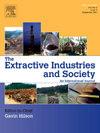Regulatory gaps and ghost indicators in Australian alumina production: The case for standardized sustainability reporting and policy reform
IF 4.3
2区 社会学
Q2 ENVIRONMENTAL STUDIES
Extractive Industries and Society-An International Journal
Pub Date : 2025-09-04
DOI:10.1016/j.exis.2025.101763
引用次数: 0
Abstract
Sustainability reporting in Australia’s alumina sector remains fragmented, failing to reflect the full scale of environmental and social impacts associated with production. While current frameworks emphasize carbon emissions, they systematically underreport critical issues such as biodiversity loss, land degradation, water resource depletion, and community health risks. These “ghost indicators” obscure the industry’s true footprint, delaying intervention and undermining accountability. This study employed a two-phase methodology, combining a systematic review of sustainability and governance literature with targeted analysis of regulatory and reporting frameworks. It identified major governance shortcomings, particularly the continued use of outdated State Agreements in Western Australia that allow producers to bypass key environmental regulations. In contrast, Queensland and New South Wales have implemented more robust frameworks, creating regulatory imbalance and selective compliance. To address these disparities, the study recommends a federally mandated sustainability reporting framework, requiring disclosure of material impacts, third-party verification, and structured stakeholder engagement. The Transition Broker Model is proposed as a governance mechanism to bridge institutional fragmentation, align policy with operational realities, and support consensus-driven reform. Strengthening sustainability reporting is not merely an administrative risk; it is essential to ensuring the alumina sector is accountable for its full footprint in a market demanding responsible production.
澳大利亚氧化铝生产中的监管缺口和幽灵指标:标准化可持续性报告和政策改革的案例
澳大利亚氧化铝行业的可持续发展报告仍然分散,未能全面反映与生产相关的环境和社会影响。虽然目前的框架强调碳排放,但它们系统性地低估了诸如生物多样性丧失、土地退化、水资源枯竭和社区健康风险等关键问题。这些“幽灵指标”掩盖了该行业的真实足迹,拖延了干预,破坏了问责制。本研究采用了两阶段方法,结合了对可持续性和治理文献的系统回顾以及对监管和报告框架的有针对性分析。它指出了主要的治理缺陷,特别是西澳大利亚州继续使用过时的国家协议,允许生产商绕过关键的环境法规。相比之下,昆士兰州和新南威尔士州实施了更强有力的框架,造成了监管不平衡和选择性合规。为了解决这些差异,该研究建议建立一个由联邦政府授权的可持续发展报告框架,要求披露重大影响、第三方验证和有组织的利益相关者参与。转型经纪人模型被提议作为一种治理机制,以弥合机构分裂,使政策与业务现实保持一致,并支持共识驱动的改革。加强可持续发展报告不仅仅是一种行政风险;在一个要求负责任生产的市场中,确保氧化铝行业对其全部足迹负责至关重要。
本文章由计算机程序翻译,如有差异,请以英文原文为准。
求助全文
约1分钟内获得全文
求助全文
来源期刊

Extractive Industries and Society-An International Journal
ENVIRONMENTAL STUDIES-
CiteScore
6.60
自引率
19.40%
发文量
135
 求助内容:
求助内容: 应助结果提醒方式:
应助结果提醒方式:


